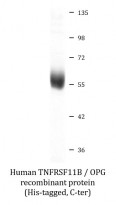ARG70269
Human TNFRSF11B / OPG recombinant protein (His-tagged, C-ter)
Human TNFRSF11B / OPG recombinant protein (His-tagged, C-ter) for Binding Activity,SDS-PAGE and Human
Overview
| Product Description | HEK293 expressed, His-tagged (C-ter) Human TNFRSF11B / OPG recombinant protein. |
|---|---|
| Tested Reactivity | Hu |
| Tested Application | Binding, SDS-PAGE |
| Target Name | TNFRSF11B / OPG |
| Species | Human |
| A.A. Sequence | Glu22 - Leu401 of Human TNFRSF11B / OPG (NP_002537.3) with 6X His tag at the C - terminus. |
| Expression System | HEK293 |
| Alternate Names | OCIF; Osteoclastogenesis inhibitory factor; Tumor necrosis factor receptor superfamily member 11B; PDB5; Osteoprotegerin; OPG; TR1 |
Application Instructions
| Application Note | Binding activity test: Measured by its binding ability in a functional ELISA. Immobilized Recombinant human TNFRSF11B at 2 µg/ml (100 µl/well) can bind Recombinant human TNFSF11 with a linear range of 2-8 ng/ml. |
|---|
Properties
| Form | Powder |
|---|---|
| Purification Note | 0.22 µm filter sterilized. Endotoxin level is <0.1 EU/µg of the protein, as determined by the LAL test. |
| Purity | > 95% (by SDS-PAGE) |
| Buffer | PBS (pH 7.4) |
| Reconstitution | Reconstitute to a concentration of 0.1 - 0.5 mg/ml in sterile distilled water. |
| Storage Instruction | For long term, lyophilized protein should be stored at -20°C or -80°C. After reconstitution, aliquot and store at -20°C for up to one month, at 2-8°C for up to one week. Storage in frost free freezers is not recommended. Avoid repeated freeze/thaw cycles. Suggest spin the vial prior to opening. |
| Note | For laboratory research only, not for drug, diagnostic or other use. |
Bioinformation
| Gene Symbol | TNFRSF11B |
|---|---|
| Gene Full Name | tumor necrosis factor receptor superfamily, member 11b |
| Background | The protein encoded by this gene is a member of the TNF-receptor superfamily. This protein is an osteoblast-secreted decoy receptor that functions as a negative regulator of bone resorption. This protein specifically binds to its ligand, osteoprotegerin ligand, both of which are key extracellular regulators of osteoclast development. Studies of the mouse counterpart also suggest that this protein and its ligand play a role in lymph-node organogenesis and vascular calcification. Alternatively spliced transcript variants of this gene have been reported, but their full length nature has not been determined. [provided by RefSeq, Jul 2008] |
| Function | Acts as decoy receptor for TNFSF11/RANKL and thereby neutralizes its function in osteoclastogenesis. Inhibits the activation of osteoclasts and promotes osteoclast apoptosis in vitro. Bone homeostasis seems to depend on the local ratio between TNFSF11 and TNFRSF11B. May also play a role in preventing arterial calcification. May act as decoy receptor for TNFSF10/TRAIL and protect against apoptosis. TNFSF10/TRAIL binding blocks the inhibition of osteoclastogenesis. [UniProt] |
| Cellular Localization | Secreted. [UniProt] |
| Calculated MW | 46 kDa |
| PTM | N-glycosylated. Contains sialic acid residues. The N-terminus is blocked. [UniProt] |
Images (1) Click the Picture to Zoom In






